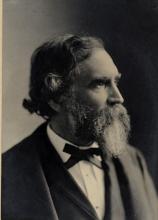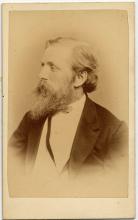Archives & Special Collections Samuel Bowles
Skip to Main Content"The Hearts in Amherst - ache - tonight": Samuel Bowles III

Samuel Bowles III (1826-1878) could not have guessed that posterity would link his name closely with that of his friend Emily Dickinson, that her enduring fame would ensure his own. Instead, if he considered the matter, he would have assumed that he would be remembered for his newspaper, the Springfield Republican, and people who knew him would have agreed. Bowles was well and widely known for his paper, which his father, Samuel Bowles II (1797-1851), known in the family as "the founder," began in 1824 as a weekly publication. Samuel Bowles III, "the editor," turned the weekly into a daily in 1844 and under his leadership it rose to prominence in the decades that followed, becoming an influential newspaper in the country. George Merriam, his biographer, said of the editor: "The great achievement of Samuel Bowles was that he built up under the limitations of a country town a paying newspaper which expressed the editor's personal opinions, bound by no party, by no school, by no clique... The editor conquered his environment. He did it by making so good a newspaper that people had to buy it. By industry and skill he won the opportunity for independence." 1
Though Bowles was a man of strong opinions and sharp intelligence, he was also deeply sentimental. His correspondence with wife Mary Bowles and friend Judge Charles Allen of Greenfield (both of whom are well represented in the Bowles-Hoar Family Papers) shows him to be strongly attached to his friends and family. Merriam, who had unique access to a wide range of information about Sam, wrote that "to many a man and woman he was known as the truest and most generous of friends. Those whom he loved felt that his friendship was inspired by an appreciation of their inmost self; that he saw what was best in them and idealized it... His friends felt that they were much to him; that he counted on them, depended on them, drew from their friendships the fullness of his life."2
People who already know Samuel Bowles will recognize him from the many photographs published in biographies of Emily Dickinson, such as these well-known images. His own 1885 biography by George Merriam contained only an engraving derived from the photograph on the right.
Bowles suffered from ill health for much of his adult life. Letters to Mary as early as 1850 chronicle his afflictions. This image reveals the careworn man not long before his death at 51. This is the "dear friend," the man Dickinson worried about and mourned too soon.
However, in the recent gift of the Bowles-Hoar Family Papers, two daguerreotypes surfaced that show a much younger Bowles. The pictures weren't identified as Sam (they had no identification at all), but close comparison with the many other photographs of Sam contained in the collection make us feel confident that we have our man. This is the Mr. Bowles Emily Dickinson met in 1858, the Sam Bowles who inspired a grieving Dickinson to memorialize him in a letter to Maria Whitney as "that Arabian presence."3 In this image he is Mr. Rochester -- dark, brooding, and mysterious.

An even earlier daguerreotype (thought to be about 1852, when Bowles would've been 25 or 26) emphasizes the youth he is said to have lost early due to overwork and chronic illness.

Small wonder that a "Black eye -- and the Blue eye -- and a Brown...hold their lashes full" (AC 681) when Bowles failed to make a scheduled visit to Amherst in 1862.
There are additional photographs of Sam Bowles in the Bowles-Hoar Family Papers, most of them already published. We know that the hitherto unpublished photographs above will please fans of Sam Bowles and add to our understanding of the force and appeal of his personality.
-M.R. Dakin
1Merriam, George S., Life and Times of Samuel Bowles, New York: The Century Company, 1885, v. I, p. 69-70.
2Ibid, p. 209.
3Johnson, Thomas L., Letters of Emily Dickinson, Cambridge, Mass.: The Belknap Press, 1958, v. III, #643.


